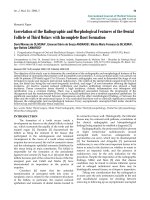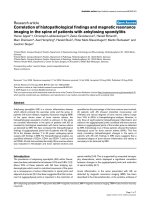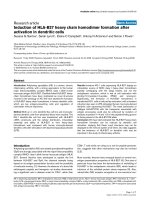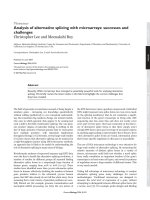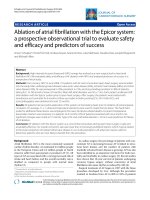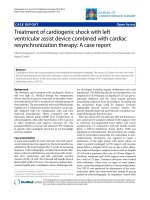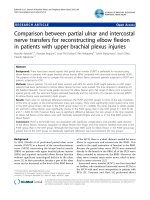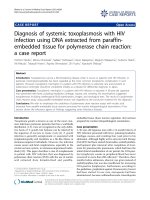Báo cáo y học: "Correlation of the Radiographic and Morphological Features of the Dental Follicle of Third Molars with Incomplete Root Formation" ppsx
Bạn đang xem bản rút gọn của tài liệu. Xem và tải ngay bản đầy đủ của tài liệu tại đây (1.19 MB, 5 trang )
Int. J. Med. Sci. 2008, 5
36
International Journal of Medical Sciences
ISSN 1449-1907 www.medsci.org 2008 5(1):36-40
© Ivyspring International Publisher. All rights reserved
Research Paper
Correlation of the Radiographic and Morphological Features of the Dental
Follicle of Third Molars with Incomplete Root Formation
David Moraes de OLIVEIRA
1
, Emanuel Sávio de Souza ANDRADE
2
, Márcia Maria Fonseca da SILVEIRA
2
,
Igor Batista CAMARGO
1
1. Postgraduation Program of Oral and Maxillofacial Surgery - School of Dentistry of Pernambuco (FOP/UPE), Brazil.
2. Department of Oral Medicine, University of Pernambuco, Camaragibe – Pernambuco – Brazil.
Correspondence to: Prof. Dr. Emanuel Sávio de Souza Andrade, Departamento de Medicina Oral – Disciplina de Patologia Bucal,
Faculdade de Odontologia de Pernambuco – FOP/UPE, Av. General Newton Cavalcanti, 1650, 54753-220 Camaragibe, PE, Brazil. Tel. /
Fax: +55-81-3458-6758; E-mail: / /
Received: 2007.12.26; Accepted: 2008.01.29; Published: 2008.02.08
The objective of this study was to determine the correlation of the radiographic and morphological features of the
dental follicle of unerupted third molars with incomplete root formation. A cross-sectional study was carried out
with 56 patients (105 teeth) aged 13 to 24 years. Panoramic radiography was used to determine the stage of root
formation to locate and measure pericoronal radiolucency. The width of the dental follicle ranged from 0.0 to 4.0
mm, the distal face being the one most frequently involved, and stage 7 of root formation showing the highest
incidence. An inactive enamel reduced epithelium and inactive epithelium remnant also showed a high
incidence. Dense connective tissue showed a high incidence, chronic inflammation was infrequent and
calcification was a common finding. There was a significant association between the progression of the
rhizogenesis and the transformation of the enamel reduced epithelium into a stratified squamous epithelium. No
significant association was found between rhizogenesis and the other morphological findings or between the
latter and the width of the pericoronal space. It was concluded that there was no clinically significant correlation
between the radiographic and morphological features. Every asymptomatic unerupted third molar should be
followed up and the follicular tissue analyzed.
Key words: Molar Third/surgery, Molar Third/radiography, Molar Third/physiopathology, Dental Sac/physiopathology,
Dental Sac/radiography
INTRODUCTION
The formation of a tooth occurs inside a
development sac known as the dental follicle or dental
sac, which surrounds the papilla of the tooth and the
enamel organ [1]. Damante [2] characterized the
follicle as being the remnant of the tissues that
participated in the odontogenesis and remained
circumjacent to the crown of a tooth whose normal
eruption has not occurred, the wall of connective tissue
and the odontogenic epithelial remnants distributed in
this tissue being its main constituents. The follicle is
responsible for the formation of the periodontal
ligament and cement [3]. Saap et al. [4] report that the
follicle becomes part of the connective tissue of the free
marginal gum and Cahill and Marks [5] have
demonstrated its importance in the process of
eruption.
Consolaro [6] states that the potential
transformation of unerupted teeth into cystic or
neoplastic ones is related to the constituent structures
of the follicle, in particular, the enamel reduced
epithelium and remnants of dental lamina located in
its connective tissue wall. Histologically, the follicular
tissues may be confused with pathosis, correlations of
the clinical, radiographic and histopathological
findings being required to establish a diagnosis [3].
Radiographically, the pericoronal follicles present
as slight semicircular radiolucencies around
unerupted teeth; however, enlargements or
asymmetries can occur, which may be misinterpreted
[3]. For Santamaria and Artegoitia [7], pericoronal
radiolucency is one of the most important factors to be
borne in mind in the decision on whether to retain or
remove an impacted tooth, and the presence of
radiolucency may be the only indication for this
procedure. Despite the importance of the radiographic
findings, Miller and Bean [8] state that disease
conditions may be found in minute follicular spaces
and in enlarged radiolucent areas there may be
histologically normal tissues, so a biopsy is imperative.
Taking into consideration that the radiograph is
in most cases the only instrument available to the oral
and maxillofacial surgeon for deciding between
removing or following up an asymptomatic unerupted
Int. J. Med. Sci. 2008, 5
37
tooth and that a number of studies show the possibility
of cystic degeneration and/or neoplastic
transformation of the follicles, the present study
evaluated the correlation between radiographic and
morphologic features of pericoronal follicles of
unerupted third molars with incomplete rhizogenesis,
with the aim of acquiring insights that might aid a
surgeon faced with such teeth.
MATERIAL AND METHODS
The sample consisted of 56 patients, of whom 17
(30%) were males and 39 (70%) were females, with a
total of 105 follicles of unerupted third molars with
incomplete rhizogenesis. Ages ranged from 13 to 24
years, with a mean of 18.3 years (standard deviation =
2.7 years) and a median of 18 years. This is a
cross-sectional study in which the sample was
established within a specific time frame. The study was
approved by the Ethics in Research Committee of the
State University of Pernambuco.
The type of radiograph used was the panoramic
one, only teeth between Nolla’s [9] stages 6 (complete
crown) and 9 (almost complete root, open apex) of
rhizogenesis being included in the study. The width of
the pericoronal space was determined from the half of
the mesial, distal and occlusal surfaces, the largest
width being selected. The harvesting of the follicle was
performed by separation at the level of the
cementoenamel junction, with the follicle being
conditioned in 10% formol. The specimens were
submitted to the routine histotechnical procedures,
semi-serial cross-sections with a thickness of 5 μm,
being selected and stained with hematoxylin-eosin
(HE). All examinations were carried out by a single
professional.
The odontogenic lining epithelium was classified
according to cell activity as inactive, hyperplastic and
absent. It was considered inactive when it presented
fewer than 20 layers of epithelial cells and when there
were no epithelial projections into the connective
tissue. It was considered hyperplastic when there were
over 20 layers or epithelial projections. Regarding
type, it was classified as enamel reduced epithelium
and stratified squamous epithelium [2,6].
The remaining epithelium in the connective tissue
was classified as inactive, proliferative or absent. It
was inactive when exhibiting a typical island or string
formation and proliferative when forming sheets or
layers of cells [10]. In the evaluation of the connective
tissue an analysis was made of the type to verify
whether it was dense or loose and whether
inflammation was present, the latter being classified as
acute, chronic or absent. The presence of calcification
was also recorded.
The data were analyzed using absolute and
relative frequencies. The Pearson chi-square test with a
significance level of 5% was employed to assess the
correlation between the radiographic and
morphological features.
RESULTS AND DISCUSSION
In the correlation between the type of lining
epithelium and the stage of rhizogenesis (Table 1), it
was found that the enamel reduced epithelium (Figure
1) was the most commonly found type at all stages of
rhizogenesis; however, at stages 8 and 9 there was a
marked increase in follicles with stratified squamous
epithelium (Figure 2), probably owing to a greater
maturation of this follicle, such a transformation being
expected.
Table 1. Distribution of type of lining epithelium according to
stage of rhizogenesis
Type of lining epithelium
Absent SSE ERE Total
Stage of rhizogenesis N % N % N % N %
# 6 2 20.0 0 0.0 8 80.0 10 100.0
# 7 7 18.9 1 2.7 29 78.4 37 100.0
# 8 5 19.2 5 19.2 16 61.5 26 100.0
# 9 10 31.3 9 28.1 13 40.6 32 100.0
Total 24 22.9 15 14.3 66 62.9 105 100.0
*p value = 0,017 (Pearson chi-square)
N = Number of teeth
SSE = Stratified Squamous Epithelium
ERE = Enamel Reduced Epithelium
Figure 1. Inactive enamel reduced epithelium (HE / 100X)
Int. J. Med. Sci. 2008, 5
38
Figure 2. Inactive stratified squamous epithelium and mild
chronic inflammation in the connective tissue (HE / 200X)
At stage 7 of rhizogenesis, proportionally, the
occurrence of stratified squamous epithelium (2.7%)
was less than expected and that of enamel reduced
epithelium (78.4%) greater than what was to be
expected, namely 14.3% and 62.9%, respectively. At
stage 9 the presence of squamous epithelium (28.1%)
was more frequent than expected and that of reduced
epithelium (40.6%) less frequent than expected. These
data prove that the transformation of the reduced
epithelium into squamous epithelium with maturation
of the follicle and consequently with increasing age
was statistically significant (p = 0.017).
These findings corroborate those of Daley and
Wysocki [11], who state that the normal follicle may be
lined by squamous epithelium and that a dentigerous
cyst probably develops when the reduced epithelium
is still present, which is at variance with Glosser and
Campbell [12] and Curran et al. [13], who argue that
any follicle with squamous epithelium should be
regarded as a dentigerous cyst. According to Slater
[14], the presence of squamous epithelium cannot be
diagnosed as a dentigerous cyst, but rather as follicular
tissue with squamous differentiation. On the basis of
these criteria, no dentigerous cyst was diagnosed in
the present study.
The use of immunohistochemistry in the study of
follicles has led to greater discussion of this
controversial question, since Adelsperger et al. [15]
demonstrated an association between squamous
differentiation and proliferative activity in the majority
of cases. The authors disagree with the view that
squamous metaplasia is a normal change that takes
place during the maturation of the follicle and state
that it represents an early pathosis, a stance supported
by the proliferating cell nuclear antigen (PCNA).
In the correlation between the type of lining
epithelium and the width of the radiographic
pericoronal space, there was no statistically significant
difference (p = 0.353); it was, however, noted that the
pericoronal space was observed even in most of the
follicles with no epithelium. The predominant widths
were 0 to 1 mm (20.7%) and 3 to 4 mm (77.8%) in the
stratified squamous epithelium and reduced
epithelium, respectively. These results were totally
different to those of Damante and Fleury [16], who
found a statistically significant association between the
presence of stratified squamous epithelium and an
enlarged pericoronal space.
In the correlation between the cellular activity of
the lining epithelium and the stage of rhizogenesis,
there was no statistical significance (p = 0.702); at stage
9, however, proportionally, there was a tendency for
cellular activity to be absent (31.3%), compared with
what was expected (22.9%), which may be due to the
maturation of the follicles. In the correlation between
cellular activity of the epithelium and width of the
pericoronal space, there was no statistical significance
(p = 0.825), but there was a tendency for the width to
be less than 3 mm in the hyperplastic epithelium
(Figures 3, 4), a result at variance with what had been
expected.
Figure 3. Specimen exhibiting hyperplastic enamel reduced
epithelium (HE / 400X)
Figure 4. Specimen exhibiting hyperplastic stratified squamous
epithelium and chronic inflammation in the connective tissue,
on which islands of inactive odontogenic epithelium are seen
(HE / 100X)
Int. J. Med. Sci. 2008, 5
39
In the correlation between the type of connective
tissue and the stage of rhizogenesis, there was no
statistical significance (p = 0.212); at stage 8, however,
dense connective tissue (57.7%) tended to occur less
frequently and loose tissue (42.3%) more frequently
than expected, namely 72.4% and 27.6%, respectively.
At stage 7, dense connective tissue (81.1%) occurred
more frequently and loose tissue (18.9%) less
frequently, differently from the results expected. In the
correlation between the type of connective tissue and
the width of the pericoronal space, there was no
statistical significance (p = 0.364).
In the correlation between inflammation in the
connective tissue and stage of rhizogenesis there was
no statistical difference (p = 0.104), but no follicle
exhibited inflammation at stage 6. At stage 9, there was
a greater occurrence of chronic inflammation (31.3%)
and the absence of inflammation (68.8%) was less
frequent than expected, namely 20.0% and 80.0%,
respectively, showing clearly that the earlier the
rhizogenesis and the more intra-osseous the tooth, the
less the inflammation. The presence of inflammation
increased with the progression of the rhizogenesis, and
this may be due to the physiology of eruption or
proximity to the oral environment [16].
In the correlation between inflammation of the
connective tissue and width of the pericoronal space,
there was no statistical significance (p = 0.439), but
there was a tendency for the absence of inflammation
up to 1.0 mm, the presence of chronic inflammation
from 1.5 mm to 2.5 mm and the absence of
inflammation between 3.0 mm and 4.0 mm. These
results are at variance with those of Damante and
Fleury [16], who found an association between
inflammation and an enlargement of the pericoronal
space despite the lack of statistical significance.
It was also observed that in 4.8% of the follicles
the following changes occurred that deviated from the
pattern of normality: proliferative sheets and layers of
epithelium; islands of epithelium in the connective
tissue with squamous metaplasia; islands of
epithelium with squamous metaplasia and an area
suggestive of cystic degeneration; islands with an
ameloblastomatoid feature; and an island suggestive
of cystic degeneration. Costa Filho [17] identified
remnants of epithelium in the connective tissue in 98%
of the specimens evaluated, only 2% of which had
proliferative cellular activity. Kim and Ellis [3] found
traces of epithelium in the connective tissue in 79% of
the cases studied and foci of squamous metaplasia in
the remnants of epithelium in 4% of the sample. The
presence of islands with an ameloblastomatoid feature
was reported in dentigerous cysts by Garrocho et al.
[18] and in follicles by Andrade [10], and cystic
degeneration by Andrade [10]. Patients with such
changes should be followed up radiographically,
hence the importance of the histopathology
examination of the pericoronal follicles.
In addition to the evaluation of statistical data,
clinical experience is of fundamental importance in the
management of asymptomatic unerupted third molars
in relation to whether or not they need to be removed.
Even though, statistically, most studies suggest that
the possibility of pathological changes is only a small
one, it does exist.
Assael [19] reported his personal analysis of the
elective removal of impacted teeth based on the
articles of Curran et al. (2002); Kugelberg (1990);
Kugelberg et al. (1985); Rood; Shehab (1990). The study
by Curran et al. served to show that the early removal
of impacted teeth is usually desirable and that their
preservation requires long-term follow-up. With
regard to the studies of Kugelberg and Kugelberg et
al., Assael concluded that, owing to the risk of bone
loss and slower healing, in patients over the age of 25
years impacted teeth should be removed only if they
exhibit clinical or radiographic signs of a pathosis.
Evaluating the work of Rood; Shehab, he observed that
teeth with completely formed roots have a greater
potential for causing an injury to the inferior alveolar
nerve and should be removed prior to the closure of
the apex. He concluded that an indication for the
prophylactic removal of impacted teeth is based in part
on the significant risk of destructive pathoses
associated with the follicular tissues.
As yet it does not seem possible to confidently
determine which unerupted third molars, whether
radiographically normal or not, but with histological
evidence of cyst formation or another pathosis, may
turn into clinically detectable lesions. Further studies
are thus required with a view to calculating the risks
involved when a decision is taken not to remove an
asymptomatic unerupted third molar.
On the basis of the results obtained and the
methodology employed, it is concluded that there was
an association between the progression of rhizogenesis
and the transformation of the enamel reduced
epithelium into stratified squamous epithelium, which
was regarded as a normal finding. There were no
clinically significant association between the
radiographic and morphological findings; accordingly,
all asymptomatic unerupted third molars should be
submitted to radiographic follow-up and any follicle
obtained from such teeth should be sent for a
histopathology investigation.
ACKNOWLEDGEMENTS
The authors wish to thank the Pernambuco State
Foundation for the Support of Science and Technology
Int. J. Med. Sci. 2008, 5
40
(FACEPE) for its financial support.
Conflict of interests
The authors have stated that no conflict of interest
exists.
REFERENCES
1. Bhaskar SN. Histologia e embriologia oral de Orban, 10th ed.
São Paulo: Artes Médicas; 1989.
2. Damante JH. Estudo dos folículos pericoronários de dentes não
irrompidos e parcialmente irrompidos; Inter-relação clínica,
radiológica e microscópica [Doctoral Thesis]. Bauru: Faculdade
de Odontologia de Bauru, Universidade de São Paulo. 1987.
3. Kim J, Ellis GL. Dental follicle tissue: Misinterpretation as
odontogenic tumors. J Oral Maxillofac Surg 1993;51:762-767.
4. Sapp JP, Eversole LR, Wisocki GP. Contemporary oral and
maxillo-facial pathology. Missouri: Mosby; 1997.
5. Cahill DR, Marks SC. Tooth eruption: evidence for the central
role of the dental follicle. J Oral Pathol 1980;9:189-200.
6. Consolaro A. Caracterização microscópica de folículos
pericoronários de dentes não-irrompidos e parcialmente
irrompidos; Sua relação com a idade [Doctoral Thesis]. Bauru:
Faculdade de Odontologia de Bauru Universidade de São
Paulo. 1987.
7. Santamaria J, Arteagoitia I. Radiologic variables of clinical
significance in the extraction of impacted mandibular third
molars. Oral Surg Oral Med Oral Pathol Oral Radiol Endod
1997;84:469-473.
8. Miller CS, Bean LR. Periocoronal radiolucencies with and
without radiopacities. Dent Clin North Am 1994;38:51-61.
9. Nolla CM. The development of the permanent teeth. J Dent
Child 1960;27:254-260.
10. Andrade ESS. Estudo histológico de folículos pericoronários de
dentes inclusos. Recife: Universidade Federal de Pernambuco
[MSc Thesis]; 1999.
11. Daley TD, Wysocki GP. The small dentigerous cyst. A diagnostic
dilemma. Oral Surg Oral Med Oral Pathol Oral Radiol Endod
1995;79:77-81.
12. Glosser JW, Campbell JH. Pathologic change in soft tissues
associated with radiographically “normal” third molar
impactions. Br J Oral Maxillofac Surg 1999;37:259-260.
13. Curran AE, Damm DD, Drummond JF. Pathologically significant
pericoronal lesions in adults: Histopathologic evaluation. J Oral
Maxillofac Surg 2002;60: 613-617.
14. SLATER LJ. Dentigerous cyst versus dental follicle. Br J Oral
Maxillofac Surg 2000;38:402.
15. Adelsperger J, Campbell JH, Coates DB, Summerlin DJ, Tomich
CE. Early soft tissue pathosis associated with third molars
without pericoronal radiolucency. Oral Surg Oral Med Oral
Pathol Oral Radiol Endod 2000;89:402-406.
16. Damante JH, Fleury RN. Contribuição para o diagnóstico do
pequeno cisto dentígero ou cisto paradentário. Pesqui Odontol
Bras 2001;15:238-246.
17. CostaFilho JZ. Avaliação radiográfica e histológica dos folículos
pericoronários dos terceiros molares inclusos com rizogênese
incompleta [MSc Thesis]. Camaragibe: Faculdade de
Odontologia de Pernambuco, Universidade de Pernambuco.
2001.
18. Garrocho AA, Loyola AM, Gomez RS, Figueiredo HS. Dos
remanescentes epiteliais na cápsula de cistos dentígeros. Arq
Cent Estud Curso Odontol 1988;25:53-60.
19. Assael LA. Impacted teeth: Reflections on Curran, Kugelberg,
and Rood. J Oral Maxillofac Surg 2002;60:611-612.
